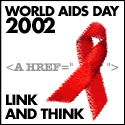Found 3599 matches from 1,400 records in about 0.1843 seconds for twitter or is or lazy.
“Each December 1, World AIDS Day, the creative community observes A Day With(out) Art, in memory of all those the AIDS pandemic has taken from us, and in recognition of the many artists, actors, writers, dancers and others who continue to create and live with HIV and AIDS.
A Day With(out) Art was created by the group Visual AIDS in New York City.
 For the last several years, Creative Time has organized a Day With(out) Art observance on the worldwide web, encouraging diverse website designers and administrators to darken their site and convey AIDS prevention and education information to their visitors.
For the last several years, Creative Time has organized a Day With(out) Art observance on the worldwide web, encouraging diverse website designers and administrators to darken their site and convey AIDS prevention and education information to their visitors.
In 1999, more than 50 webloggers took part in a project called a Day With(out) Weblogs. In 2000, nearly 700 personal weblogs and journals of all sorts participated. In 2001, the number was over 1,000. The personal web publishing community — weblogs, journals, diaries, personal websites of every kind — has continued to grow and diversify.
Once again, everyone who produces personal content on the web is invited to participate a global observance of World AIDS Day. In recognition of the variety of sites participating — E/N sites, weblogs, journals, newspages and more — and to differentiate it from other, similar endeavors, a Day With(out) Weblogs became Link and Think.”
Despite the corny name, Link and Think is one of the more effective online grassroots marketing campaigns I’ve seen. While a Day With(out) Weblogs was more of a memorial and show of solidarity, Link and Think also takes a more forward looking view.
Of the Web logs I check regularly, MetaFilter posted decent set of links. The facts, stories, and images are chilling, but it’s also nice to see a bit of perspective — for instance, asking why AIDS dominates the public health debate.
From The Telegraph, UK:
Arabic love poem puts US Gulf base on red alert
By Jack Fairweather in Kuwait (Filed: 05/12/2002)
US marines in Kuwait were put on full alert yesterday after an unidentified person wrote a love poem in Arabic on a military vehicle.
The marines, unable to translate the simple phrase which begins many Arabic love songs, called the alert when they thought the message contained a terrorist threat. A translator was summoned and confirmed it was merely a poem, the words reading: “I love you forever. Your beauty is incomparable.”
“We’re not used to such things,” said one American soldier serving at Camp Doha, the American military base in Kuwait where troops are preparing for a possible war against Iraq.
It transpired that the message was not meant for the marines but for a lovesick teenager by the name of Fatima.
The Yes Men, corporate trouble makers and designers of the WTO parody site, marked the 18th anniversary of the Bhopal disaster with the launch of Dow-Chemical.com, a straight-faced parody site using the design of the original, and a cheeky press release in the voice of the corpoation. Unfortunately, their cleverness got the best of them and the site was brought down in a matter of days. (Mirror sites are now up.)
 While funny at first, in context the parody Web site feels a bit thin. Sure it’s fun to parody the public relations language used to bathe coroporations in the soft glow of environmental and corporate responsibiliy. But also marking the anniversary were thousands of people marching in the streets of Bhopal.
While funny at first, in context the parody Web site feels a bit thin. Sure it’s fun to parody the public relations language used to bathe coroporations in the soft glow of environmental and corporate responsibiliy. But also marking the anniversary were thousands of people marching in the streets of Bhopal.
An estimated 500,000 people were affected when 40 tons of lethal gases leaked from Union Carbide Corporation’s pesticide factory in Bhopal in 1984. Today, the number of deaths stands at 20,000. Virtually nothing has been done to clean up the site, and the water used by people for everyday needs is still contaminated. And via Reuters:
“Former Union Carbide chairman Warren Anderson faces charges of culpable homicide and Indian courts have repeatedly asked New Delhi to seek his extradition from the United States where he now lives in retirement. Anderson, considered a fugitive from Indian law for refusing to face charges in its courts, could be jailed for 10 years and fined if found guilty.”
So what of design and social change? Well, a bit of design forensics determined that it was a failure of design that led to the disaster. On December 2, New Scientist published an article on their investigation of the accident and recently released documents that identify the reasons for the failure and show that the company that built and owned the Bhopal plant cut crucial corners and safety features from its design of the plant.
“Union Carbide was forced to release the documents last month by a court in New York state that was hearing a class action suit filed by Bhopal survivors in 1999. According to New Scientist, Carbide’s 1972 memo specified that the US headquarters would either perform all design work for the plant, or approve designs done elsewhere. The report said that on the basis of fresh evidence, the US Company could be tried for negligence only if the Indian government joined the campaigners in the US lawsuit.”
...
Further info via rtMark press release:
“Burson-Marsteller, the public relations company that helped to ‘spin’ Bhopal, has meanwhile sued college student Paul Hardwin for putting up a fake Burson-Marsteller site, http://www.bursonmarsteller.com/, which recounted how the PR giant helped to downplay the Bhopal disaster. Burson-Marsteller’s suit against Hardwin will be heard next week by the World Intellectual Property Organization.
Hardwin, unable to afford a lawyer, has composed a dryly humorous 57-page rebuttal to the PR giant’s lawsuit. On page 7, for instance, the student notes that Burson-Marsteller’s stated goal is
‘to ensure that the perceptions which surround our clients and influence their stakeholders are consistent with reality.’
Hardwin goes on to assert that his satirical domain is doing precisely that, by publicizing
‘academic and journalistic materials about Burson-Marsteller’s involvement with and relationship to, for example, Philip Morris and the National Smoker’s Alliance, a consumer front group designed to create the appearance of public support for big-tobacco policies; Union Carbide and the deaths of 20,000 people following the 1984 disaster in Bhopal; and political regimes such as that of Romanian dictator Nicolae Ceausescu and more recently Saudi Arabia following the events of September 11; and to properly associate them with the relevant Trademark so that they may be understood accordingly by Internet users.’
In response to the suit’s claim that ‘a substantial degree of goodwill is associated with [the Burson-Marstellar Trademark]’ Hardwin offers much ‘evidence to the contrary’ including ‘a newspaper headline in which the Complainant is characterized as “the Devil.”’
The primary goal of RTMark is to publicize corporate subversion of the democratic process. Just like other corporations, it achieves its aims by any and all means at its disposal. RTMark has previously helped to publicize websites against political parties, political figures, and entities like the World Trade Organization and the World Economic Forum.
Upgrading to a new cell phone? Don’t throw out your old one! If you live in the U.S., send it to Call to Protect.
“Call to Protect is a national wireless phone collection drive designed to provide domestic violence victims and organizations with one of the most powerful tools in the fight against domestic violence... a wireless phone. The program is a partnership between the Wireless Foundation, the National Coalition Against Domestic Violence and Motorola who have worked together since 1996 to provide free phones to victims of domestic violence through the program.”
Free emergency airtime is donated by wireless service providers. Check the FAQ.

Blamed for an attack on America, non-white Americans and residents of foreign descent had become so hated that in February 1942 the President ordered their arrest and detention at “relocation centers” around the country. 110,000 men, women, and children were removed from their homes, rounded up at gun point, and locked up for the next three years.
From a Web site on Owens Valley History, the site of the Manzanar detention center:
“Two-thirds were first-generation American citizens. They lived in American cities, attended American schools, and thought of themselves as Americans... They were removed from their homes, schools, and businesses, and brought to Manzanar and nine other camps like it.... A few were second-generation Americans.... Neither they nor their parents had ever known any other life than their life in the United States.
Almost a third of the prisoners were Japanese citizens, resident aliens by definition of the U.S. immigration law.... All of this group had lived in the United States at least eighteen years, since American borders were closed to Japanese immigrants in 1924. All had been specifically barred from applying for American citizenship. The right to become an American citizen was not allowed to the Japanese until 1952, when quotas were introduced.”
The Library of Congress Web site features a collection of 244 photographs of Japanese-American internment at Manzanar taken by reknown landscape photographer Ansel Adams. Depicted are scenes of daily life, agricultural scenes, sports and leisure activities, and portraits of the detainees. Browse via the subject index or the thumbnail view.
From the Library page about the collection:
“In 1943, Ansel Adams photographed the Manzanar War Relocation Center at the suggestion of its director, his good friend and fellow Sierra Club member, Ralph Merritt. Adams wanted to contribute to the war effort while at the same time show the loyalty of the Japanese-Americans interned at Manzanar... In 1944, some of these images were published in Adams’ book Born Free and Equal. The book had a limited circulation, perhaps due to the political climate of war-time America. When offering the collection to the Library, Adams said in a letter, ‘All in all, I think this Manzanar Collection is an important historical document, and I trust it can be put to good use...The purpose of my work was to show how these people, suffering under a great injustice, and loss of property, businesses and professions, had overcome the sense of defeat and despair by building for themselves a vital community in an arid (but magnificent) environment.’”
The internment camps were small planned communities built with volunteer, contract, and forced labor on the site of a ghost town.
“The center was located at the former farm and orchard community of Manzanar. Founded in 1910, the town was abandoned when the city of Los Angeles purchased the land in the late 1920s for its water rights. The Los Angeles aqueduct, which carries Owens Valley water to Los Angeles, is a mile east of Manzanar.”
In addition to vital necessities of food and shelter, the camp had its own school, church, factories, hospital, and even a local paper. See this essay for details on the design and operations of the camp.
 40 years after the closing of the camps, the United States government conceded that the relocation was based on racial bias rather than on any true threat to national security. 50 years later in 1992, President Bush offered reperations and an apology.
40 years after the closing of the camps, the United States government conceded that the relocation was based on racial bias rather than on any true threat to national security. 50 years later in 1992, President Bush offered reperations and an apology.
Congress established the Manzanar National Historic Site, containing 550 acres, on March 3, 1992. It is currently administered by the National Park Service, under the U.S. Department of Interior. See the Park Service Web site.
Nearly 60 years after the war, Yoshie Hagiya, age 77, Oxnard High class of 1942, received her school’s valedictorian honors.
Misleading ads, voter intimidation, malfunctioning and confusing ballots... problems continue to plague U.S. elections. And designers are starting to step up.
Design for Democracy is an non-profit organization in Illinois . It’s mission is to:
“Improve the informational and physical systems involved in the American voting experience through education and user-centered research, evaluation, strategic design, and implementation, in order to support an environment in which every voter counts.”
 From the about page:
From the about page:
“The team is national. Our focus is local. We approach election issues with a unique perspective: as designers. To do that we have specialists in graphic design, industrial design, interface design, Web site development, anthropology, and usability, all of whom understand the human factors in the voting.
We are objective and independent, and we are valued for our ability to consider all possible solutions without preference to a particular technology, ideology or organization. Our commitment is to the public good and we adhere to standards and practices that preserve our client-focused point of view. Our recommendations and the materials we create will be based on meeting election code requirements and understanding what will be easily implementable by those who operate elections.
Design for Democracy... is not aligned or associated with any corporations, organizations or entities that advocate a specific voting product or service.
Design for Democracy works directly with election officials in both large and small jurisdictions to maximize their resources and achieve specific goals.
For large jurisdictions, we can comprehensively study singular issues and determine areas for improvement in processes, procedures and materials. Then we can apply our knowledge and experience to recommend and implement those improvements.
With smaller jurisdictions, we can apply proven strategies and solutions, including templates that can be easily adapted to a particular need. These templates have already been used successfully in two Cook County, Illinois elections.”
Affiliated organizations include the Industrial Designers Society of America, the American Institute of Graphic Artists, the Usability Professionals Association, and the University of Illinois at Chicago.
Thus far they’re primarily active in Chicago, with a project in Oregon. After a proposed redesign of Chicago’s butterfly ballot, the group then worked to change the Illinois Election Code to implement the redesign and legally allow the use of lowercase letters in candidate names. Student projects include the design of a more universally accessible voting booth and a more efficient document handling system.
Also, the nod to “user-centered research” in the mission statement refers mainly to field research and documentation rather than actual participation by voters and poll workers in the design process. At minimum, the usability professionals should be able to incorporate user feedback and testing into the process rather than just at the initial data gathering phase.
Once the voting process is redesigned, a hard look at how design can facilitate public participation in other processes (such as candidate making, ballot initiatives, campaign financing, city planning, etc.) would be much welcome.
Otherwise, this seems like a good first step towards engaging designers in civic affairs.
A follow up to this brief blog item on ballot design from May 2002.
“Some of the statutes and regulations enforced by agencies within the [U.S.] Department of Labor require that notices be posted in the workplace. The Department provides electronic copies of the required posters. Some of the Department of Labor’s posters are available in languages other than English. They are also available in electronic form.”
More are not very beautiful and seem designed by bureaucrats, but they must be posted in a conspicuous place as a notice to employees and a warning to employers. The posters implicitly call on employees to monitor the complience of their employers, and some even provide phone numbers and contact info. They are designed in a no-nonsense institutional non-style, that speaks of authority and bureaucratic indifference.
Are you a confused employer? The Department of Labor even has an online an electronic walkthrough of the poster requirements and laws.
Many states have their own posters and requirements, too. The posters generally fall into the following areas: minimum wage and age, job safety and health, information about emergency family medical leave, worker’s compensation, and polygraph and equal opportunity protection.
None of the posters I found address your federally protected right to organize and form a union in your workplace — though South Carolina, a “right-to-work” state, describes this right in their big labor law poster.
Below are a sampling of posters produced by the states.

In addition to their statutory language version, Oklahoma provides a plain language version (shown), complete with color photos and clear subject headings.

Tennessee’s poster for employees offers a loud warning for those would forget their rights.

Child labor law == happy kids. Just like in the clip art of this Kansas poster.

Hawaii’s posted is clear and direct, with a splash of color.

Because the information on this South Carolina poster is so organized, I don’t think the poster was consciously designed to be obscure. But what employee would read such a dense poster in the kitchen?
There are also companies who market compliance, selling laminated, redesigned, all-in-one versions of the posters.
“Michael Miller is a geographer with over a decade of providing geographical services to organizations involved in monitoring global human rights.
These services include map research, cartographic production for publications, web sites and presentations, satellite imagery analysis, and geographic information systems.
His maps have appeared in media throughout North America and Europe, and on the web. Clients have included: Human Rights Watch, Amnesty International, the US Holocaust Memorial Museum, Global Witness, and Public Affairs, Rutledge, Yale University and Westview Presses.“
Some sample maps at his Web site, rightsmaps.com:

Since the collapse of the bubble economy, the number of homeless in Japan has risen from 1,000 in 1992 to over 30,000 in 2002. The long recession means a severe shortage of unskilled day labor in construction and manufacturing. The average age of the homeless here is 55 and they are almost entirely men. What little day labor there is usually goes to younger men. With no work, no money, and no where to go, the men buid their own shelter on public land along the boardwalk by the river and along the edges of the few public parks near the employment brokers (both legal and illegal). The houses are neat and trim, built to fight the weather and cold and to provide some basic comfort. They are also collapsible. Once a month the government comes and sweeps the houses off the boardwalk. It’s usually the same day every month, so the guys dismantle their houses and haul the materials over the wall... to rebuild them later that afternoon.
The houses are tucked away behind fences and under bridges to be less visible, and are kept neat in a conscious effort not to disturb passersby. Unlike in the States, I’ve not encountered any panhandling. They may be hungry, they may be desperate, but some things are just not done.
 Almost all the structures use the same blue vinyl tarp. The tents in the parks are looser and less constructed than along the river, presumably because the sweeps in the parks take place weekly.
Almost all the structures use the same blue vinyl tarp. The tents in the parks are looser and less constructed than along the river, presumably because the sweeps in the parks take place weekly.
The situation is utterly absurd... but not unlike that of my own neighborhood. There’s no place to go, says the City, you just can’t stay here.
After a mass eviction in 1993, the “Coalition of the Homeless in Shinjuku” was formed to provide mutual support, to seek livelihood and employment guarantees, and to stop the evictions, referred to by the government as “environmental cleaning.” After years of denying the problem, the national government passed a controversial law in August 2002 to provide some relief. Still, the evictions continue and the additional shelter has not yet been built. It remains to be seen how the new measures will proceed. The guys don’t want handouts, they just want work, affordable housing, and to be treated with respect.
Read more about the Movement of the Coalition of the Homeless on the Web site of the Resource Center for Homeless Rights.
 “[The Homeland Security Cultural Bureau] is protecting the interests of the country’s national security by employing efforts to direct and guide the parameters of cultural production.”
“[The Homeland Security Cultural Bureau] is protecting the interests of the country’s national security by employing efforts to direct and guide the parameters of cultural production.”
“Which artists and strategies may be most aligned with the agents of terror? Who are the postmodernists and do they really pose a threat? Again, here we present to you a cogent argument for rethinking our culture and for aligning our needs for security with a new relation to art.”
A very official-looking, straight-faced satire site.
See also http://www.whitehouse.org/ and http://www.gwbush.com, two other satire sites. I found whitehouse.org’s Department of Homeland Security page when searching for the real Department of Homeland Security page.
page 1 2 3 4 5 6 7 8 9 10 11 12 13 14 15 16 17 18 19 20 21 22 23 24 25 26 27 28 29 30 31 32 33 34 35 36 37 38 39 40 41 42 43 44 45 46 47 48 49 50 51 52 53 54 55 56 57 58 59 60 61 62 63 64 65 66 67 68 69 70 71 72 73 74 75 76 77 78 79 80 81 82 83 84 85 86 87 88 89 90 91 92 93 94 95 96 97 98 99 100 101 102 103 104 105 106 107 108 109 110 111 112 113 114 115 116 117 118 119 120 121 122 123 124 125 126 127 128 129 130 131 132 133 134 135 136 137 138 139 140 141 142 143 144 145 146 147 148 149 150 151 152 153 154 155 156 157 158 159 160 161 162 163 164 165 166 167 168 169 170 171 172 173 174 175 176 177 178 179 180 181 182 183 184 185 186 187 188 189 190 191 192 193 194 195 196 197 198 199 200 201 202 203 204 205 206 207 208 209 210 211 212 213 214 215 216 217 218 219 220 221 222 223 224 225 226 227 228 229 230 231 232 233 234 235 236 237 238 239 240 241 242 243 244 245 246 247 248 249 250 251 252 253 254 255 256 257 258 259 260 261 262 263 264 265 266 267 268 269 270 271 272 273 274 275 276 277 278 279 280 281 282 283 284 285 286 287 288 289 290 291 292 293 294 295 296 297 298 299 300 301 302 303 304 305 306 307 308 309 310 311 312 313 314 315 316 317 318 319 320 321 322 323 324 325 326 327 328 329 330 331 332 333 334 335 336 337 338 339 340 341 342 343 344 345 346 347 348 349 350 351 352 353 354 355 356 357 358 359 360
[ Back ]
[ Next ]



